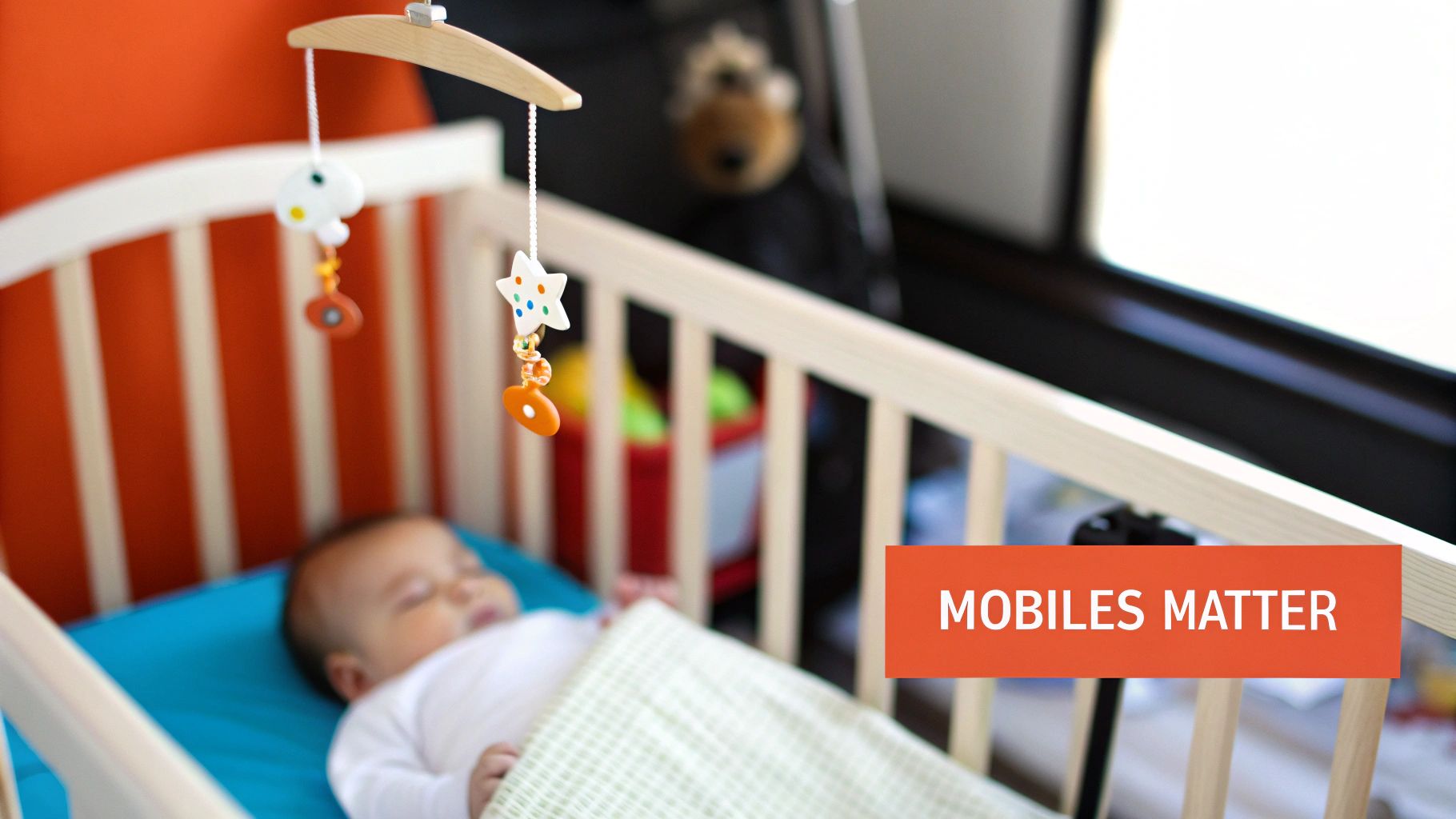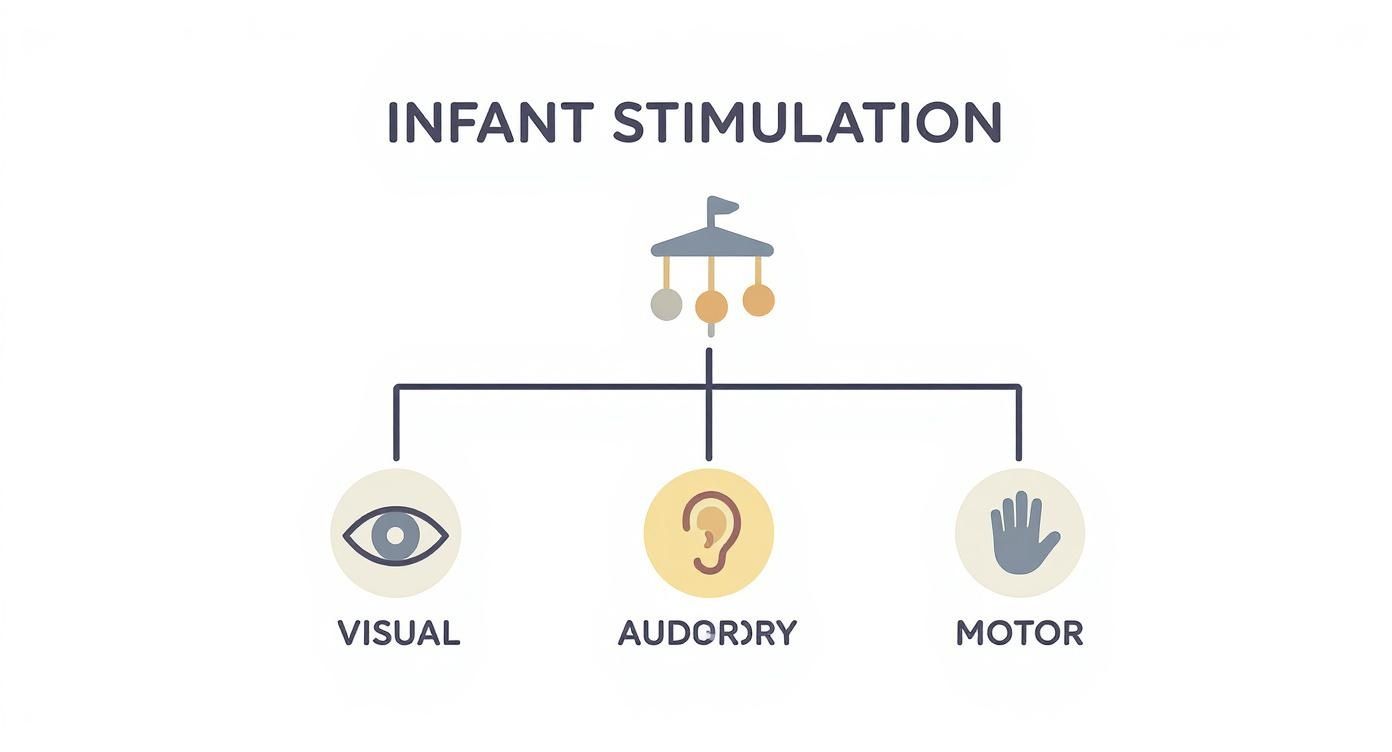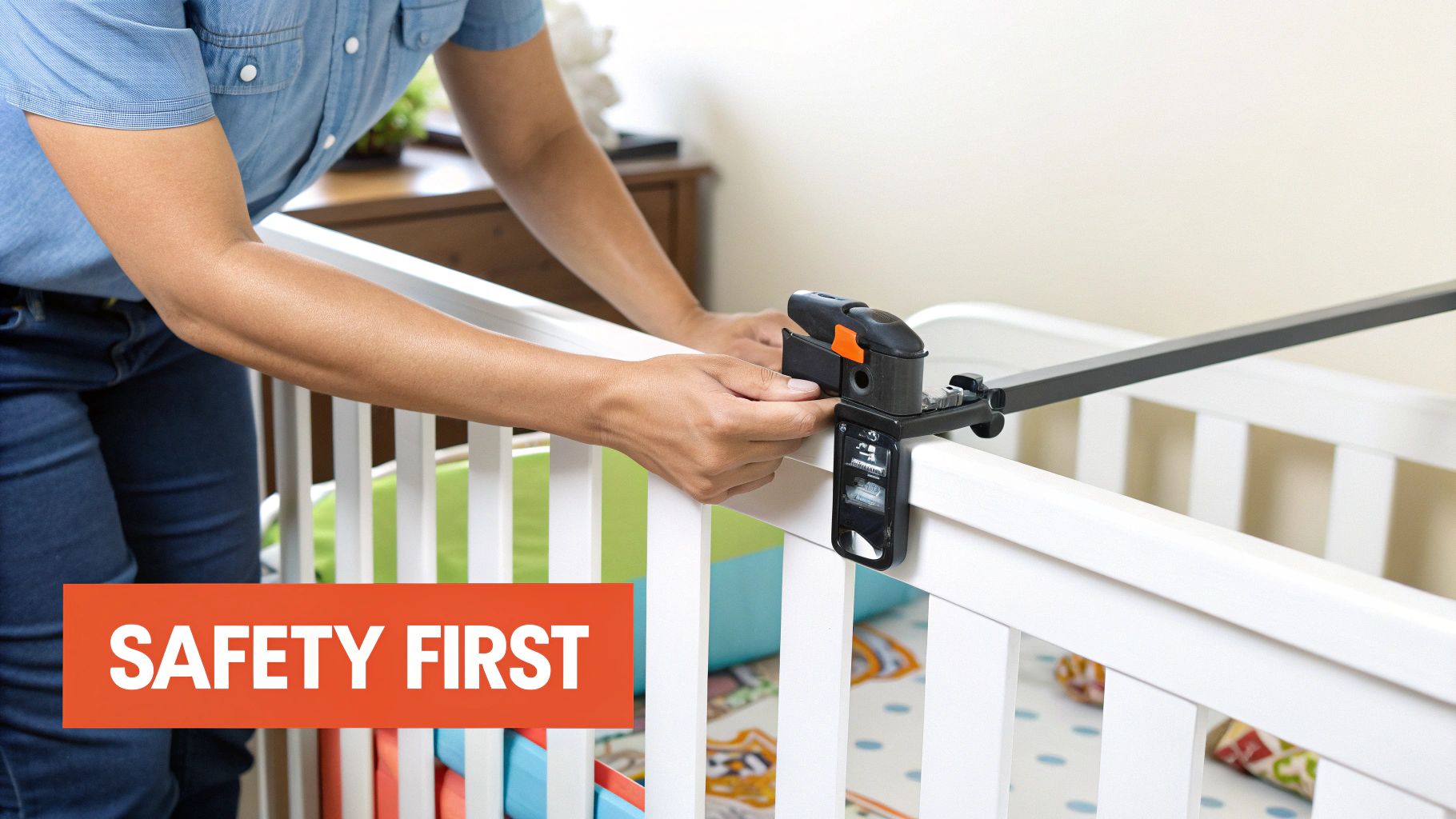
Mobile Toys for Infants: A Guide to Developmental Benefits
It's easy to look at a baby mobile and see a charming nursery decoration. But that whimsical contraption hanging over the crib is one of your baby's first and most powerful educational tools. Think of it as a tiny gym for your infant's developing mind and senses, setting the stage for major developmental milestones.
More Than Just Decoration: The Developmental Role of a Mobile

For a newborn, the world is a fuzzy, novel place. A mobile offers a single, captivating point of focus, giving their new eye muscles a gentle workout and helping them learn to track movement. It’s their first real lesson in concentration and visual development.
As those colorful shapes drift and sway, your baby’s brain is hard at work. This simple act of observation builds foundational skills for more complex learning, hand-eye coordination, and spatial awareness down the road.
A Gateway to Sensory and Cognitive Growth
The educational value extends beyond sight. The best mobile toys for infants provide a multi-sensory experience. The gentle motion introduces the concept of movement and physics, while a musical mobile's soft sounds help fine-tune auditory processing. This stimulation helps your baby build new neural pathways in their rapidly growing brain.
Parents increasingly recognize the value of these early learning tools. The global market for infant and toddler toys reached approximately USD 16.7 billion in 2024, with developmental toys being a significant component. You can get a better sense of the baby toy market and its growth here.
A well-chosen mobile doesn't just entertain; it educates. It's a silent teacher that introduces your baby to patterns, movement, and the very concept of object permanence—the idea that things still exist even when you can't see them.
This guide focuses on looking past aesthetics to find a mobile that truly enriches your baby's world. We’ll explore how to select one that supports these crucial areas of development:
- Visual Development: Strengthening eye muscles and improving focus.
- Cognitive Skills: Introducing concepts like cause and effect and object permanence.
- Motor Skills: Encouraging early reaching and kicking movements.
By understanding what to look for, you can choose a mobile that’s not just decor—it’s an integral part of your baby's journey of discovery.
How a Simple Mobile Boosts Your Baby's Brain Development
That simple mobile hanging over the crib is doing more than just looking pretty. It's your baby’s first introduction to a world of sensory information—a developmental gym for their brain. It’s not about mere distraction; it’s about actively forging the neural pathways that form the bedrock for all future learning. Every gentle spin and soft melody is a lesson for their growing mind.
This educational process begins with the most dominant sense for a newborn: their vision.
Building Stronger Visual Skills
At birth, a baby's eyesight is still developing. They can only focus clearly on objects about 8-12 inches away, and their world is largely in shades of gray. This is precisely why high-contrast, black-and-white patterns are so captivating for them.
The slow, gentle movement of mobile toys for infants provides the perfect target for their eyes to practice tracking. As they follow the dangling shapes, they're strengthening their eye muscles and learning binocular vision—making both eyes work together as a team. This simple exercise is crucial for developing focus, tracking, and depth perception, skills essential for everything from recognizing faces to eventually crawling and walking. Using high-contrast toys is a key Montessori principle, exemplified in these Montessori-inspired black and white mirror toys.
Tuning In to Sounds for Auditory Development
Beyond the visual display, many mobiles add a layer of sound. A mobile with soft chimes or a gentle melody does more than soothe a fussy baby—it actively sharpens their hearing. Lying in their crib, your little one starts to connect the pleasant sounds with the movement they see above them.
This association helps them build sound localization skills, which is their ability to identify where a sound is coming from. You might notice them turning their head toward the music—a small but significant step in understanding their environment and the concept of cause and effect.
A mobile functions as a multi-sensory learning hub. It teaches an infant that the world is a predictable place where actions (like movement) lead to reactions (like sound), a core concept for cognitive growth.
Kicking Off Early Motor Skills
As your baby becomes more fascinated with the mobile, you’ll likely witness another developmental leap: their first purposeful movements. Those adorable kicks and flailing arms are often a direct response to the interesting toy hanging just out of reach.
This is the very beginning of gross motor skill development and hand-eye coordination. While they can't touch it yet, the desire to interact with the mobile encourages them to activate their muscles and explore their body's capabilities. This drive to connect with the world is why parents are invested in developmental toys. The global baby toys market was valued at around USD 16.43 billion in 2024 and is expected to grow, highlighting the parental priority on early development. You can read more about the growth drivers of the baby toys market here.
These early wiggles and kicks are the building blocks for major milestones like rolling over, sitting up, and eventually, grabbing objects with intention.
Choosing the Right Mobile for Your Baby's Developmental Stage
Navigating the options for baby mobiles can be overwhelming. The key is to focus on what your baby needs at their specific stage of development to ensure the mobile supports their growth without causing overstimulation.
For newborns, simplicity is paramount. Their vision is just beginning to focus, making high-contrast, black-and-white patterns ideal. These bold designs give their developing eyes a clear object to lock onto, helping to strengthen crucial ocular muscles.
Once your baby reaches the three-month mark, their world begins to fill with color. This is the perfect time to introduce a mobile with bright primary colors and more complex shapes. It provides their budding color vision with a beneficial new challenge. If you're preparing your nursery, we have a comprehensive list of essentials in our guide to the best baby products for newborns.
Understanding Different Mobile Styles and Their Benefits
Mobiles generally fall into two categories: classic wind-driven models and modern battery-operated ones. Each offers a different kind of sensory experience.
A simple felt or wooden mobile that sways with the natural air currents provides soft, unpredictable movement. This encourages calm observation and sustained focus, acting as a quiet visual lullaby.
Electronic mobiles, in contrast, offer consistent rotation and often include features like music or white noise. These are excellent for actively engaging your baby’s attention with predictable, multi-sensory input that reinforces cause-and-effect learning.
The choice between a simple, wind-driven mobile and a feature-rich electronic one depends on your baby's temperament and your developmental goals. One promotes quiet focus, while the other offers active entertainment and sensory integration.
To help you decide, let's break down which features are most beneficial for each age group.
Mobile Features by Baby's Age
This table provides a quick reference for matching a mobile's features to your baby's developing senses, ensuring you choose a toy that is perfectly suited to their current abilities.
| Feature | Newborn (0-3 Months) | Older Infant (3-6 Months) |
|---|---|---|
| Visual Design | High-contrast, black-and-white patterns and simple geometric shapes to support developing vision. | Bright primary colors, varied shapes, and more detailed objects to stimulate color perception. |
| Movement | Gentle, slow, and unpredictable motion to encourage visual tracking without overstimulation. | Slightly faster, more consistent rotation to hold attention and introduce patterns. |
| Auditory Features | Optional; soft, gentle chimes or no sound at all to prevent sensory overload. | Soft melodies or soothing nature sounds can be introduced to aid auditory development. |
By tailoring the mobile to their stage, you're not just hanging a decoration—you're providing a powerful developmental tool.
This infographic effectively illustrates how a single mobile can nurture different areas of your baby's development simultaneously.

As you can see, a well-chosen mobile can support visual tracking, auditory processing, and eventually motor skills as your baby begins to reach. It's a simple toy with impressive benefits for a growing brain.
A Parent's Checklist for Mobile Safety

While a mobile is a fantastic developmental tool, safety is the highest priority. An improperly installed or poorly designed mobile can quickly become a hazard. This checklist will guide you through essential safety measures, ensuring your baby's nursery is both stimulating and secure.
A safe mobile experience begins with a rock-solid installation.
Secure Installation Is Non-Negotiable
Whether your mobile clamps to the crib rail or hangs from the ceiling, the connection must be completely secure. For crib-mounted mobiles, ensure the clamp is tightened firmly and does not wiggle. Check it periodically, as a baby’s movements can vibrate hardware loose over time.
If you opt for a ceiling-hung mobile, use a hook screwed directly into a ceiling joist, not just drywall, to guarantee it can support the weight without risk of falling.
The single most important rule of mobile safety is placement: always hang the mobile completely out of your baby’s reach. Your little one should be able to see it, but never, ever touch it.
This fundamental rule is your best defense against entanglement or choking hazards, the primary risks associated with mobile toys for infants.
Mind the Materials and Construction
Beyond installation, the mobile itself requires a thorough safety inspection. Before purchasing, examine its materials and construction.
- Choose Non-Toxic Materials: Look for mobiles made from natural wood, organic cotton, or felt that use non-toxic, baby-safe paints and dyes to ensure a healthy nursery environment.
- Avoid Small, Detachable Parts: Inspect the mobile for any small beads, buttons, or other components that could detach. Every part should be securely attached and large enough to not pose a choking hazard.
- Check for Long Strings: Cords or strings on a mobile must be short. The generally accepted safety standard is that any string longer than seven inches poses a potential strangulation risk.
This level of safety awareness should extend to the entire nursery. For a comprehensive overview, our article on how to childproof your home offers a room-by-room guide to help you create a safe space for your little one.
Know When to Remove the Mobile
A mobile is a temporary feature of the crib. There is a clear developmental point when it must be removed for safety.
The moment your baby can push up on their hands and knees or when they reach about five months old—whichever comes first—the mobile must be taken down. At this stage, they are strong enough to potentially reach up, grab it, and pull it down into the crib.
By following these essential safety guidelines, you can confidently provide your baby with the wonderful developmental benefits of a mobile while maintaining a safe nursery environment.
Keeping Your Mobile Clean and Safe
A well-maintained mobile is a safe mobile. Regular cleaning and simple inspections are all it takes to keep this important developmental toy hygienic and functioning correctly, offering you peace of mind.
Like all nursery items, a mobile can collect dust and germs. Fortunately, establishing a simple cleaning routine is easy and depends on the mobile's material.
A Simple Cleaning Guide
Follow these steps to keep the mobile fresh and ready for your baby's enjoyment.
-
Wooden Mobiles: Use a soft, damp cloth with a small amount of mild soap. Gently wipe down all surfaces without soaking the wood. Let it air dry completely before re-hanging.
-
Plastic Mobiles: These are typically the easiest to clean. Use a baby-safe disinfectant wipe or a cloth with soap and water for a quick and effective cleaning.
-
Fabric or Felt Mobiles: For minor spots, use a damp cloth with a gentle, baby-friendly detergent. For a deeper clean, always check the manufacturer’s instructions, as some fabric components may be hand-washable.
Knowing how to care for these items is increasingly important, as many are purchased online. The online baby products market is projected to reach USD 35.43 billion by 2033, giving parents access to a wide variety of mobile toys for infants from around the world. Understanding material care is key to their longevity and safety. Find more details on the growth of online baby product sales here.
Beyond cleaning, a quick weekly safety check is highly recommended. This two-minute inspection can identify potential issues before they become problems.
During your check, gently tug each hanging component to ensure it's secure. Look for any frayed strings or signs of wear. Most importantly, confirm that the entire mobile is still firmly fastened to its crib or ceiling mount.
From Crib Toy to Keepsake
When your little one outgrows their mobile, it doesn't have to be stored away. You can repurpose it into a beautiful piece of nursery decor.
By shortening the strings so it remains well out of reach and hanging it in a corner of the room, you can transform it into a lovely memento from those precious early months.
Got Questions About Baby Mobiles? We’ve Got Answers
It’s natural to have questions when choosing and using a mobile. As a parent, you want to ensure you're providing the best for your child. We've gathered answers to some of the most common queries.
Consider this your quick-reference guide for using a baby mobile confidently and effectively.
When Is the Right Time to Introduce a Mobile?
You can introduce a mobile right from day one. The first few weeks are an ideal time to hang a simple, high-contrast mobile above the crib or changing station. A newborn's vision is best at a distance of about 8 to 12 inches—the typical hanging distance for a mobile.
The gentle motion and bold shapes provide valuable stimulation for their developing eyes, helping to build ocular muscle strength and laying the foundation for visual tracking and depth perception.
How Can I Tell if My Baby Is Overstimulated?
Mobiles are designed to be engaging, but it is possible for a baby to become overwhelmed, especially by models with extensive sound, light, and motion. Learning your baby's unique cues is key.
Here are common signs of overstimulation:
- Averting Gaze: They will intentionally turn their head and eyes away from the mobile.
- Increased Fussiness: Instead of appearing calm and curious, they may begin to fuss or cry.
- Tense Body Language: Look for jerky arm movements, a rigid body, or tightly clenched fists.
If you observe these signs, simply turn the mobile off or remove it for a while. You can reintroduce it later for shorter periods.
A mobile should be a source of calm wonder, not stress. Trust your baby's cues; they are the best expert on their own sensory needs.
Learning their communication signals is a rewarding part of parenting and helps you find the right balance between beneficial stimulation and a peaceful, happy baby.
How Long Should a Mobile Stay On?
While there is no single rule, a good guideline is to limit mobile sessions to about 15 to 20 minutes at a time. This duration typically provides sufficient sensory input without becoming overwhelming.
The best time to use it is when your baby is awake, content, and ready for gentle engagement—perhaps after a feeding or diaper change. It is important to remember that mobiles are for "playtime," not "sleep time," as the movement and sounds can be too stimulating for a baby who is trying to fall asleep.
Think of it as a beneficial workout for their developing brain before they settle down for a quiet nap.
Can I Hang a Mobile Somewhere Besides the Crib?
Absolutely! While the crib is a traditional location, mobiles are very versatile. Hanging one over a play mat can make tummy time more engaging, encouraging your baby to lift their head and strengthen their neck and shoulder muscles.
You can also use one over a bassinet or changing table to provide a welcome distraction. Just ensure you follow the same safety rules regardless of location:
- It must be attached securely.
- It must be positioned completely out of your baby's reach.
- All strings must be short (less than seven inches).
Changing the location provides your baby with a new perspective and keeps the experience fresh and interesting, supporting their development throughout the day.
At MiniPrecious, we’re passionate about creating products that are beautiful, safe, and truly beneficial for your baby’s development. We want to help you nurture your little one's growth while giving you complete peace of mind.
Explore our handpicked collection of nursery essentials at https://miniprecious.com.

